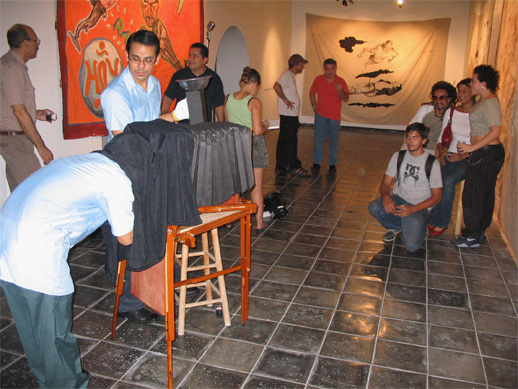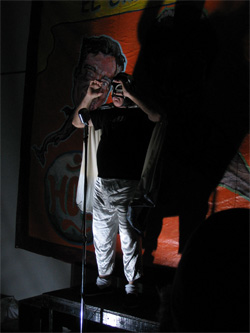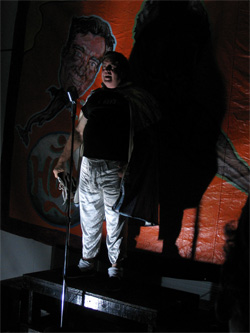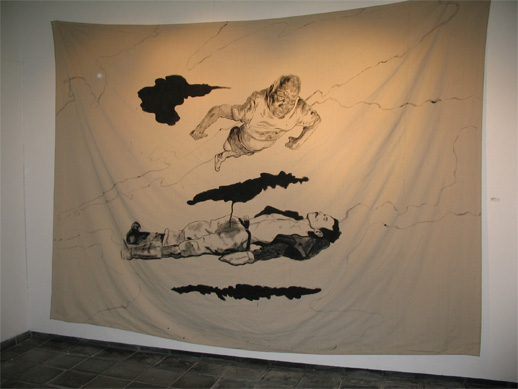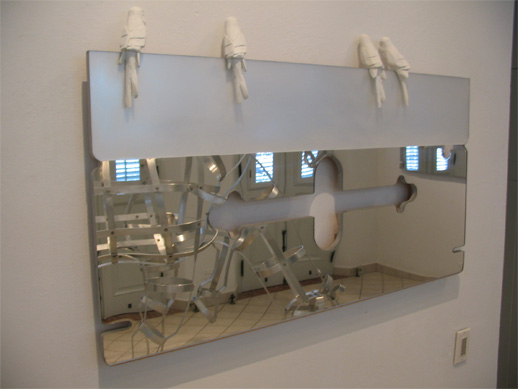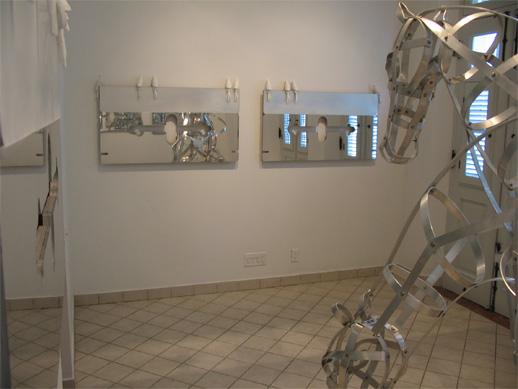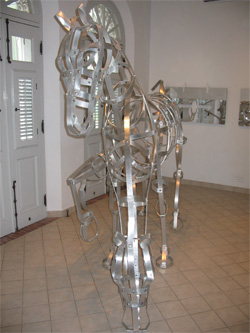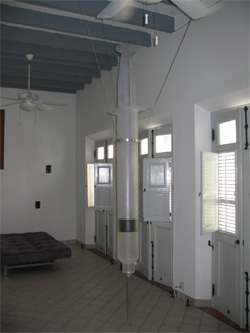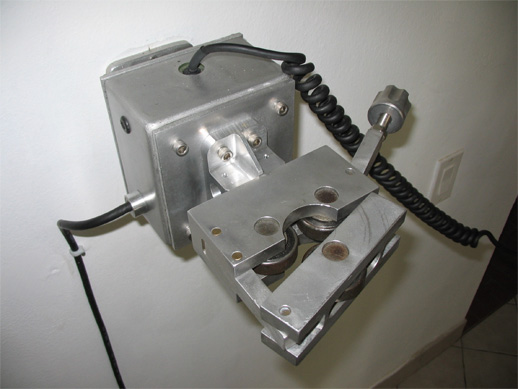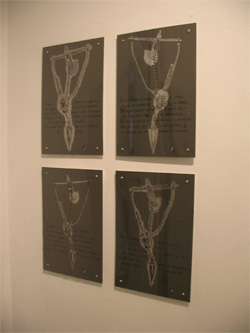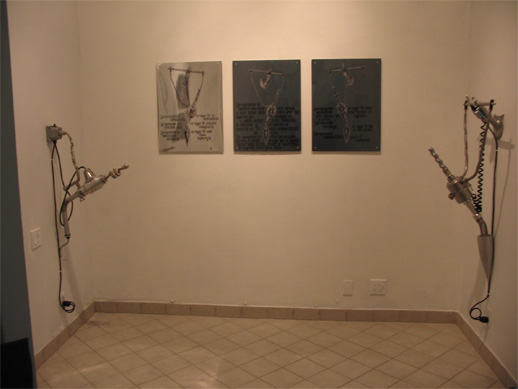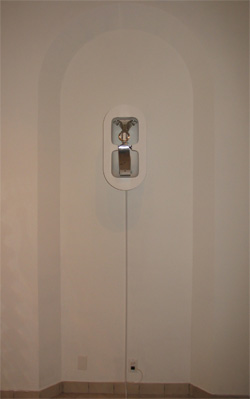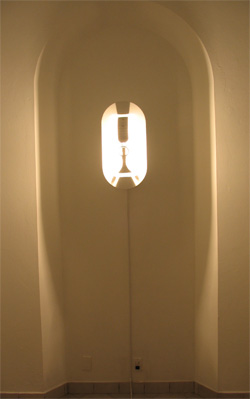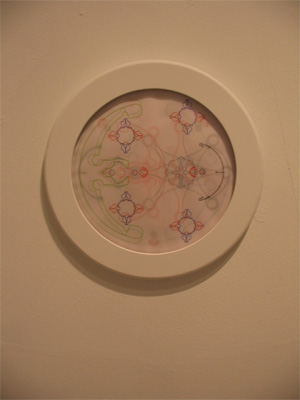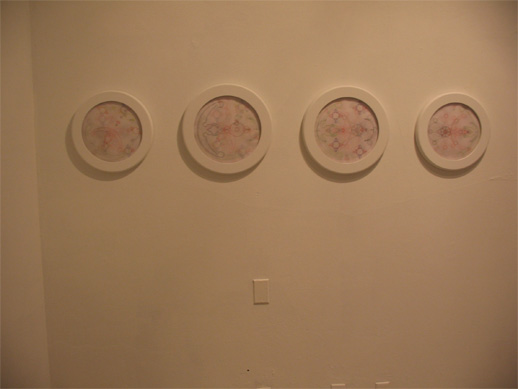
Onward Ho!Art has not been all fallen heroes, boredom, and lack of irony in recent weeks. In fact, Viejo San Juan itself is the site of a couple of exhibitions that are well worth noting; one for its theatrical flair, fairly dripping ironies of history and human pathology, and the other for its unabashed princeliness. Remember that the Rotund radar is not always as listo as it should be when it comes to the fresh and the underground, so there have likely been other openings that got by our upraised snoots.
Visitors were handed religious tracts which bore on their backsides warnings about unexpected loud noises, smoke, and strobe lights, and the dry-ice effects were nicely cheesy, as were the lights-out, stentorian declamations by the actors. For the finale everyone stood around in the haze wearing 3-D glasses.
The paintings are fine—Vargas makes good use of the grunginess of the giant canvases, especially when miscellaneous stains present themselves as malign spirit-forms or, in the case of an expiring Toni B, the phemonemon of a dying man pissing upwards—but there is no duplicating the tent revival atmosphere of opening night. Vargas himself did little more than sign people in and gladhand visitors, but his beaming presence made him the evening’s most able performer.
The painting above, “La sombra,” featuring Tonio Bicicleta in his death throes, appears in the background of the photo with the camera above. Galeria Liga de Arte is located at 1 Calle Beneficiencia in Viejo San Juan. Call 787-722-4468 for directions, hours, and the closing date of the show. The Bad and the BeautifulDown the road from La Liga de Arte, at the supremely elegant though highly temporary digs of Crema Gallery, there is an exhibition of an entirely different order altogether: three young turks who love steely, shiny surfaces with puzzle-piece structures underneath. Each fellow puts his fascination to a different use—on one hand, Charles Juhasz-Alvarado and Arnaldo Morales are social animals, attuned to the personal and historical drifts of their milieu, while Erik Guzman-Shorrock is a tinkerer of the first water—but in general they are all intent, streamlined, and modern in their conceptual approaches, with none of the loosey-goosey spiritualist hijinks or rank theatricality that make José Luis Vargas’s works such atavistic fun. The Crema show is titled “Every Line Means Something,” but we wouldn’t want you to think that the boys are fussbudgets, gadget freaks, all work and no play. Morales’s dangerous-looking machine-sculptures are notorious pranks, and Juhasz-Alvarado is known for being playful on a grand scale. But each artist is, indeed, up to serious business in one way or another. Juhasz-Alvarado has largely dedicated himself to heroin in this show, or at least to speculating about addiction’s poetic cross-threads, if not its more dreadful feelings and effects. In one installation, mirrored razor-blades with their perching parkeets reflect a two-headed horse that dominates the room; a beast at once sketchy, made of mere lines, yet as solid as the steel ribbons that outline its form. Upstairs, a syringe as tall as the high-ceilinged room hangs in wait.
From the top down: one of a series of sculptures, each titled “Espejo,” 2006, mixed media, 3' x 1.5" x 3" each. An installation view with the work “Caballo,” also from 2006, made of aluminum and stainless steel. To the right, an installation view with the 2006 work “Jeringuilla,” made of acrylic, and to the left, another view of the “Espejo” series and “Caballo.” The installation seems a novelistic inquiry into feelings and possibilities, not an easy polemic. And it’s funny that Morales, too, is in a literary mood for this outing, showing texts with drawings emblazoned on paper and also on a foil-like reflective surface, along with a number of his usual steely contraptions. This is an unexpected turn for anyone who knows the artist strictly by his whirling, whipping, vibrating, hammering, and churning objects; his mechanical-mindedness, in other words, and his predilection for creating things that look like they might hurt you or someone you love. What’s surprising about Morales’s texts is not what you read there—the broadsides consist of found fragments extolling sensuality, knowledge, and honesty and disdaining their opposites—but the fact that an artist of such determined outwardness and certainty would put so much reliance on something as ephemeral as words. It’s impressive. We’ve always admired Morales’s audacity and his tenacious grip on his work, and it’s intriguing to wonder how far he’ll go with language.
At the top, the base of Arnaldo Morales’s “Puñe,” 2006, which is made of industrial materials. Next down, on the left, Crema owner Mónica Vicéns Lucchetti holds the thing itself. On the right, a series of drawings on paper from 2006, each titled “Ley” and measuring 12" x 18", and below, between the sculptures “Sababa,” left, and “Monocristo,” right, a series of drawings on paper from 2006, each titled “yo digo” and measuring 19.5" x 26". Guzman-Shorrock is more purely the technician among the three artists, although trying to make such easy distinctions is a fool’s errand. The artist’s finished works always demand the participation of the viewer. You must trip a pedal, watch, look away; at least that’s the case with the work we saw in the recent “The (S) Files” at Museo de Arte de Puerto Rico, and with what’s at Crema as well. But as if to prove how endlessly fascinating the process of making his art works is, Guzman-Shorrock has included in his installation drawings, templates, and the orignal aluminum sheet from which the parts of the work were punched. Now this might seem self-indulgent in some artists, but the fact is that Guzman-Shorrock’s drawings are of more interest to us than his finished sculpture, which strikes us as entertaining and impressively complicated but, on an emotional level at any rate, a bit of a one-trick pony. It’s on or it’s off. The drawings are evocative of many things, not limited to machine shop templates, astronomical charts, topographical maps of alien landscapes, medieval drawings, and needlework patterns. We like the crayon-like colors. We love the morphing forms. This work is as much fun as José Luis Vargas’s stains.
From the top down: on the left, the unlit “Mini Eclipse” from 2006. On the right, the sculpture alit. Next, one of a series of vellum prints from 2006, each titled “Mini Eclipse Template Drawing” and measuring 14" x 14". Below, the entire series. And last, an aluminum plate titled “Mini Eclipse Negative Template,” 2006, 61" x 48" x 1/4". Crema Gallery, or Cr3ma as it sometimes bills itself, is located in Viejo San Juan at Calle Sol 102. The gallery is there only briefly and then moves to a new location. “Every Line Means Something” is on view by appointment. Call 787-721-8597 to visit the show, but do it soon. The gallery web-site—www.CR3MA.com—has the latest news. |

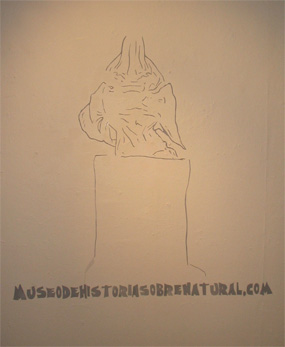 The gallery at La Liga de Arte de San Juan continues to surprise us all with its exhibitions of artists whose works are, to put it in terms of our bohemian past, considerably beyond the fringe. José Luis Vargas would no doubt greet this description with a belly laugh. His circus- billboard-size canvases are part of an ongoing series—what he calls a “life-long project”—he has created under the jolly rubric The Museum of Supernatural History, which appears to be the name of the show. A visit to the gallery is de rigueur to fully appreciate the very weird dimensions of Vargas’s thinking, but also the depth of his heart and his embrace of some of the darker precincts of Puerto Rican history. He fancies fond, marginal outlaws like Tonio Bicicleta and seems to believe that serious poking about in the clammier realms of the metaphysical is a means to enlightenment. Opening night showed Vargas as a road-show vaudevillian. There was an old-fashioned large-format studio camera complete with shroud—to record any “spirits”in the vicinity of the subjects—to go along with several sagging, raggedy-canvas paintings, plus a rousing performance by Aravind and Rafael concerning the nature of memory, dreams, and the monsters among us.
The gallery at La Liga de Arte de San Juan continues to surprise us all with its exhibitions of artists whose works are, to put it in terms of our bohemian past, considerably beyond the fringe. José Luis Vargas would no doubt greet this description with a belly laugh. His circus- billboard-size canvases are part of an ongoing series—what he calls a “life-long project”—he has created under the jolly rubric The Museum of Supernatural History, which appears to be the name of the show. A visit to the gallery is de rigueur to fully appreciate the very weird dimensions of Vargas’s thinking, but also the depth of his heart and his embrace of some of the darker precincts of Puerto Rican history. He fancies fond, marginal outlaws like Tonio Bicicleta and seems to believe that serious poking about in the clammier realms of the metaphysical is a means to enlightenment. Opening night showed Vargas as a road-show vaudevillian. There was an old-fashioned large-format studio camera complete with shroud—to record any “spirits”in the vicinity of the subjects—to go along with several sagging, raggedy-canvas paintings, plus a rousing performance by Aravind and Rafael concerning the nature of memory, dreams, and the monsters among us.